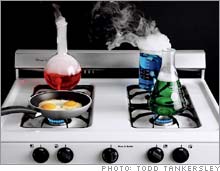|
How to build your own basement biotech
Business 2.0 reports that homegrown labs could soon be a source of new lifesaving discoveries -- and riches for those who can make them on the cheap.
(Business 2.0 Magazine) - Everyone thinks they know what's involved in creating a new drug: $800 million in R&D, followed by a 10-year machete march through the thickets of FDA regulations. That daunting prospect is hardly the thing to get an entrepreneur's heart pumping. But here's a thought to quicken your pulse: Big changes are afoot in the life sciences, and basement biotech is neither as far away nor as expensive as you might think. In fact, you can buy all the equipment you need - DNA synthesizers, sequencers, and so on - for as little as $50,000 on eBay (Charts).
But what about the FDA, you ask? While you might dream of producing an AIDS vaccine in your basement, succeeding at this is highly unlikely, so drug regulations are the least of a basement biotech entrepreneur's concerns. Far more plausible is that talented amateurs will make patentable discoveries that lead to boffo new therapies or crops. Big Pharma will pay handsomely just for solving a piece of a puzzle. Take startup Agribiotics, which Alison McIver and her sister and parents started in their Cambridge, Ontario, family basement in 1997 and sold in March to Germany's Merck (Charts) KGaA for $25 million. Most basement biotechies will likely spend far more time simulating the behavior of the gene sequences they dream up on a computer than cooking them up in a home laboratory. For this, you only need a powerful workstation. But the software for such work is still crude; Bio-Spice, a popular open-source biosimulation program, doesn't cut it, in my opinion. In chip design, engineers have long used software tools to simulate complex circuits before etching them on silicon. The biotech industry needs its equivalent ofCadence Design Systems (Charts), maker of the industry-standard software used by chip designers to model semiconductors. With better tools in place, lone inventors could test endless variations of compounds and molecules to see how they might interact in cells. And the analogy with chip design doesn't end there. We already have molecular circuits and light-sensitive bacteria - what's stopping someone from putting the two together and introducing a biodigital camera that's cultivated in a petri dish rather than stamped out on an assembly line? Gene hacking's not for everyone, however. For an easier path to wealth, and one that doesn't require a biotech background, there are always medical devices - the high-tech gear that's an ever-growing part of the way health care is delivered. Medtronic (Charts), today a $60 billion medical-device company, was founded in 1949 by Palmer Hermundslie, a lumber mill worker, and Earl Bakken, a graduate student in electrical engineering. They started out repairing hospitals' electronic gear and then decided to build their own. The difference between then and now? You can skip the grunt work of bootstrapping. Venture capitalists are tail-waggingly eager to give money to medical-device startups. Venture investing in medical devices rose 23 percent last year to $2.1 billion. Boomers are breaking down like old cars, and there are rapidly growing markets for everything from replacement joints to better wheelchairs. The first person to invent a sport-utility chair will make a mint. Don't bet against basement biotech. The drug industry - with its decade-long development programs, billions in lost research expenditures, and declining new drug approval applications - is ripe for disruption by real entrepreneurs. Hey, they could hardly do worse than the incumbents. _____________________________________________________
Paul Kedrosky is the executive director of the William J. von Liebig Center for Entrepreneurism and Technology Advancement at the University of California at San Diego and a VC with Canadian firm Ventures West. |
|

